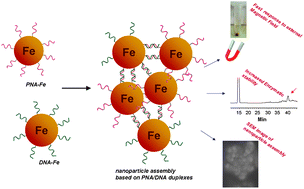An alternative strategy to synthesize PNA and DNA magnetic conjugates forming nanoparticle assembly based on PNA/DNA duplexes
Abstract
In this paper we report an alternative approach to synthesize PNA and DNA magnetic nanoconjugates. Chemical modifications were introduced on the 130 nm dextran-magnetite particles to obtain poly-functionalized particles containing reversible bonds sensitive to the cellular environment and suitable for the direct introduction of unmodified oligomers. Due to the polyvalent nature of the nanoparticles, when the complementary PNA and DNA nanoconjugates were mixed together, the resulting duplex structures bring to a nanoparticle assembly driven by W–C base pairs. The formation of the nanoparticle assembly was investigated by optical spectroscopy (UV, FTIR), scanning and transmission electron microscopies and by the analysis of the macroscopic behaviour of the nanoparticle-conjugates in aqueous solution with and without magnetic field application. Furthermore, serum stability assays revealed an increased enzymatic resistance in FCS of the PNA/DNA nanoconjugate duplex with respect to the unconjugated duplex. The described nanosystem could be extended to other duplex structures, possibly involving aptameric sequences of biomedical relevance, and could be very useful in order to obtain high local concentration at the target site of both the duplex and the magnetic nanoparticles in biotechnological applications.


 Please wait while we load your content...
Please wait while we load your content...